| Friday, April 29, 2011 – Isabela Island – East side
Wake up bell at 5:45 with Isabela Island out the window. We had some coffee/tea and boarded the pangas for a pre-breakfast hike at the Tintoreras, known for marine iguanas and lava.
After a dry landing, we did a loop trail through sharp lava mounds topped with marine iguana poop. (Pepe said this sharp lava with irregular surfaces is called “a'a' lava.”) The marine iguanas covered the landscape and blended in so well with the lava. From 200,000 to 300,000 marine iguanas call Galapagos their home and I think about half of them were here this morning.
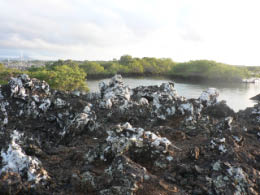
Isabela Island |
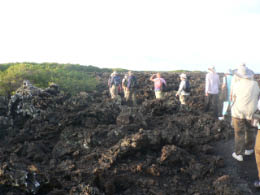
Isabela Island |
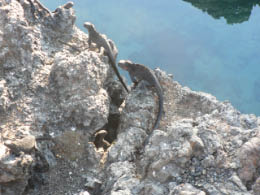
Marine iguanas |
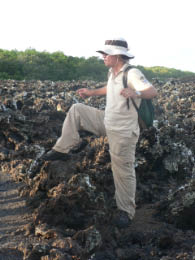
Pepe |
We saw batches of youngsters cling to the rocks and to each other. The lava rocks can really heat up. They go to the water to cool off or, when they’re on land, they go on tippy toes and face the sun to minimize their body exposure to the sun.
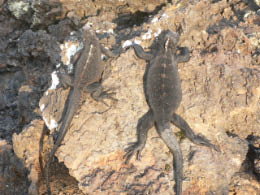
Young iguanas clinging to the rocks |
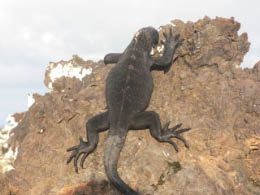
Young iguana clinging to the rocks |
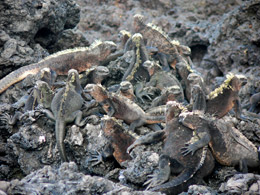
Iguana pile |
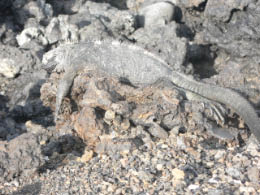
Iguana blending in |
We didn’t see any large marine iguanas in the groups – don’t know where they were hanging out. Maybe they were out to sea. There’s no need to hide in the Galapagos. We watched them almost motionless except when they spit out the salt from their nostrils. The big guys can reach up to a three feet in size and weigh 40 pounds. There must be plenty of seaweed to feed all the critters I saw. They eat for about an hour every day at low tide and bask in the sun.
I am now a big iguana fan. They are harmless and seem to be gentle. Their big claws help them hang onto underwater rocks. Pepe said their claws will eventually evolve to webbed feet. They are able to lower their heart rates (to 4 beats a minute) and stay under water for an hour – plenty of time to mate under the sea.
The trail was beautiful in the early morning sun with the dark lava, the green mangroves and the turquoise water always in sight. Along the way there is always a sea lion wanting your attention. Today was no different.
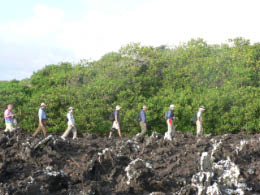
Hikers |
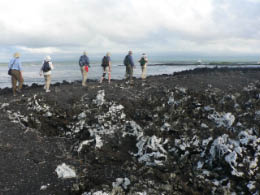
Trail along the beach |
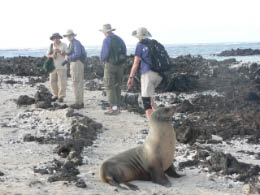
Sea lion |
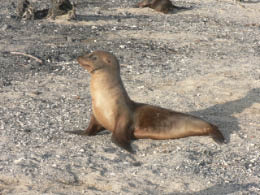
Sea lion wanting attention |
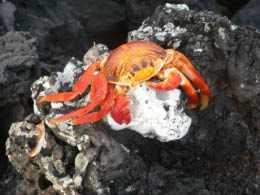
Crab |
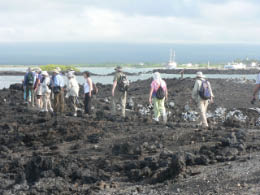
Along the trail |
We also saw some lava lizards scampering about –but they wouldn’t stay still long enough for a photo. I really enjoyed the early morning stroll among the iguanas in the strange fields of lava covered with patches of lichen and dripping with iguana poop – it’s home sweet home to the iguanas and lizards. We said goodbye to the Tintoreras on Isabela Island and boarded the panga for the ride back to the ship – looking forward to a big breakfast.
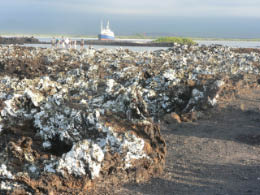
Lava covered with iguana poop |
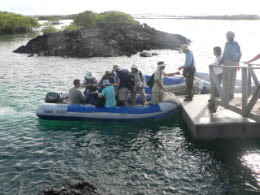
Leaving Tintoreras |
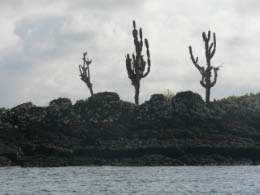
Cactus grove |
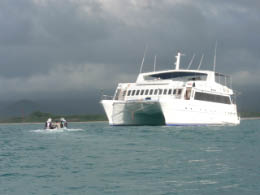
Back to the Archipel II |
At 9:30 we were ready to go on another outing. We boarded the panga to take a little tour before our deep water snorkel at the tide pools. I left my camera behind so I had to pay more attention, wanting to record every detail in my brain. As we rode the panga to shore, I watched several frigates and boobies dive bomb into the water to catch their breakfast. We passed by a military-looking boat that said, “GUARDACOSTA” – which I assumed means “Coast Guard.”
At the dock we had our first penguin spotting – what a treat. Penguins can swim up to 25 miles per hour. The little guys looked so happy darting in and out between the sea lions having, what looked like, the time of their lives. We walked through the mangrove trees on a long wooden path. We had to duck below several of the large mango branches that arched over the planked path.
We jumped into the water at the tide pool, where the ocean current was strong. In the water with my snorkel mask in place, I immediately went into my own world discovering the beauty that lay beneath. Mostly I saw black fish with a bit of yellow and big blue eyes – funny looking. I watched the underwater landscape go from shallow rocky areas to deep canyons. I was jolted out of my marine life by Bill’s yelling. I didn’t have my hearing aids on, but I knew the fear in his voice. Lisa and I got caught in a swift current taking us out to sea (actually just back to the dock – but “out to sea” sounds more dramatic). Bill was yelling at me to swim across the current – but it was impossible to make this flipper-less body go. Out of nowhere came Pepe. I grabbed his arm and he swam me to the edge of the mangrove swamp and told me to hang on while he went to rescue Lisa. Like a dart he was out of there and off to save Lisa’s life as well. He’s our hero. I found my footing and the rocks below and was able to make my way to the rest of the group. All in all, it was a lovely snorkel – I’m glad I lived to tell about it.
| We came back to the ship with an hour until lunchtime. I caught William rubbing Fran’s leg in the ship’s lobby. Actually he was changing her bandage. She had nicked her shin last night while the boat was rocking and rolling. It was quite a sight – you go Girlfriend!
Pepe came in with a live octopus to scare us girls. That octopus gave its life for our lunch. I filled up on French fries, salad, fruit and soup and didn’t partake of the octopus. |
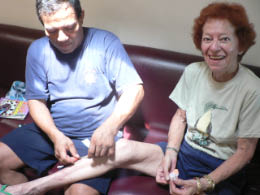
William and Fran |
At 2:30 we boarded the pangas for our afternoon adventure. We docked at Puerto Villamil on Isabela Island. From the dock, half of us got on a funky open air bus while the other half rode in a minivan. Bill and I preferred the funky bus.
We drove only a few miles out of town to a brackish water lagoon where flamingos sometimes hang out. (There are 28 lagoons on the island – a very good place to attract flamingos.) We were lucky enough to see a flock of about 4 or 5 feeding on brine shrimp in the water. They were very pink, meaning they were very well fed. Pepe said the recent rains have provided a feast for the flamingos. They were passive feeding meaning they just waded through the water scooping up shrimp in their beaks. When the food supply is low, they must stick their beaks into the mud and do their “flamingo” circle dance gathering up whatever is available. Then spit out all the non-edible stuff.

Flamingo |

Flamingo |
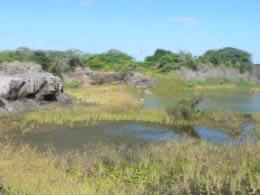
Lagoon |
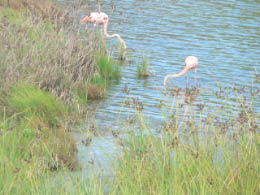
Flamingo |
Pepe said that hawks are the flamingos’ predators – always looking for the eggs. The goats were once a problem, but have been eradicated.
We saw two water towers, the main water supply, just beyond the lagoon. One was recently built to pump the fresh water for the town. The freshwater spring was discovered in a lava tube. I didn’t listen to the details because I was taken by the flamingos.
|
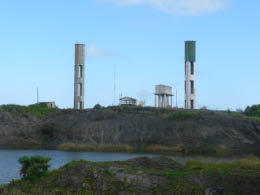
Water towers |
Pepe said the flamingo skeletal system is like ours; except their hips are attached to their lungs and their ankles are where we think their knees should be. Pepe sure knew a lot about flamingos.
The next stop was a giant tortoise breeding center. It was much like all the other breeding centers we’ve frequented on the trip – pens, babies, etc. But this one was special because Pepe’s friend from childhood has worked there for 8 years as a park ranger. He spent a lot of time showing us an example of a tortoise egg and the different stages of tortoise embryos gathered from cracked tortoises’ eggs. It was great to learn more about tortoises and to see Pepe with his old pal – a very special visit.
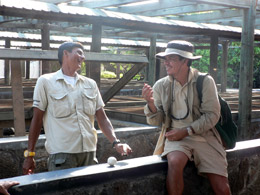
Pepe and his friend |
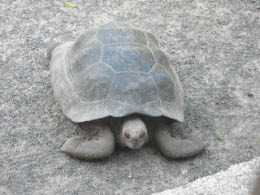
Giant tortoise at breeding center |
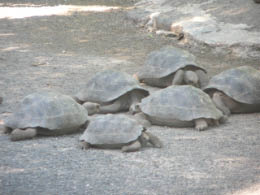
Tortoises |
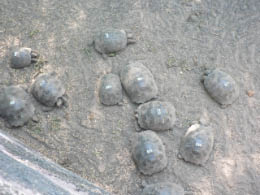
Babies |
Pepe spotted a poison apple tree (manchineel tree) and quizzed us to see if we remembered from our first day. We failed the test. He had to tell us again about the milk substance that is irritating (like our poison ivy) and the fruits are poisonous. Only the giant tortoises can digest these little apples. The tree looked beautiful and green – but STAY AWAY!
On the way out we passed by the corral for the Giant Galapagos Tortoises with their "dome-shelled" or "saddle-back." |
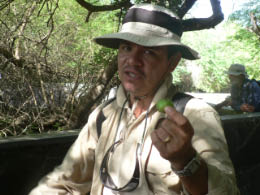
Pepe and poison apple |
The Spanish word for saddle is “galápago” and that’s why the Spanish Conquistadors named them that. Because of the saddle configuration, or curved shell, they are able to stretch their necks up to reach the taller cactus. There are different species of Galapagos tortoises and they vary in size from 60 to 700 pounds. The shell on the larger species can be 4 feet in length. What’s cool about the Galapagos Tortoises is that they formed a buddy system with the finches. |
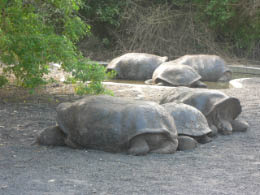
Giant Galapagos Tortoises |
They will extend their necks so that the finches can pick off ticks. They seem so gentle and peaceful – no wonder they were almost annihilated. These were the only “saddleback” Galapagos Tortoises I saw in all of the Galapagos – so I’m glad I had a look.
We took the funky bus back to Puerto Vilamil, the little beach town on the south eastern tip of Isabela. This place is truly a tropical paradise with turquoise water, white fine sand and swaying palm trees – plus a lot of beautiful babes sunning themselves.
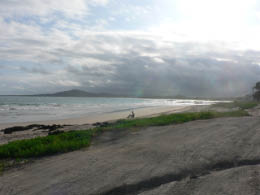
Beach on Isabela Island |
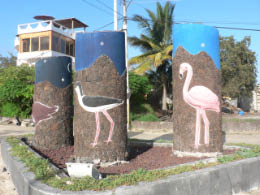
Puerto Vilamil |
Pepe told us we had an hour and a half to snorkel, walk on the beach, hang out, or watch the crew play soccer. He asked if we had any questions. My reply was, “Is there anyone here who would loan us some money for a beer.” Steve flashed a 20 dollar bill and we were set. The beer joint on the beach had beers for a buck or two and they hit the spot.
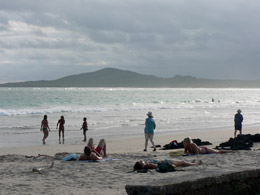
Beach on Isabela Island |

Beer with Claudia and Steve |
Afterward, Steve and Claudia went with us to track down flamingos in a brackish lake behind the town. Steve, the avid bird watcher, was happy to find a couple more bird species. He said that the Galapagos only has 60 species of birds and so far, he’s found and photographed 35. It’s a race to the finish. (Update: Steve ended up, at the end of the trip, with 41 species – Guess he’ll have to come back.)
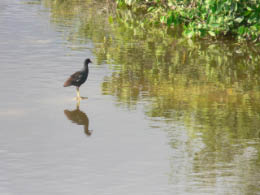
Common Gallinule on Isabela Island |

American Oystercatchers |
Bill and I walked back to the gorgeous beach and watched our soccer team (Archepell II crew members) play one heck of a soccer match. According to Pepe, the losers have to buy Gatorade for the other team. (They played several games so I don’t know how their Gatorade bet came out.)
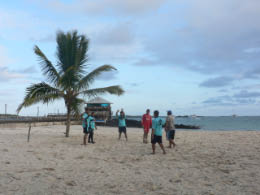
The big soccer game |
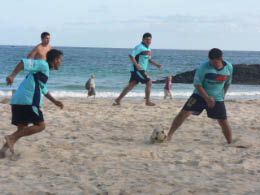
Archipel I vs. Archipel II |
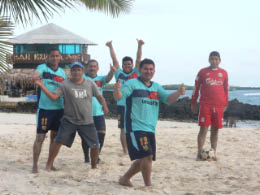
Our team won |
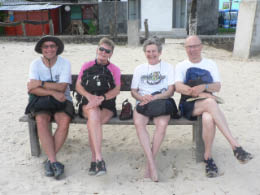
Rooting for Archipel II |
This town has good vibes. It’s difficult to believe that it once was a penal camp for the meanest of the mean. Started back in 1949, the guards had the prisoners build a wall of lava blocks, just to keep them busy. Many a prisoner lost his/her life over a useless project. The “Wall of Tears” still stands at the edge of town.
While we were waiting for the panga to pick us up, we watched the marine iguanas crawl up and down the lava walls. How do they do that?
A couple of local kids about 7 or 8 years old were running and jumping off the peer. We were afraid they would break their necks, but they seemed to know what they were doing.
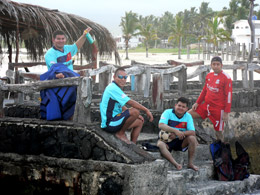
Our crew and soccer team |
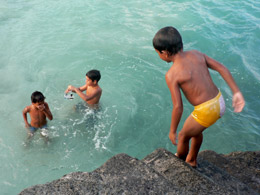
Kids jumping off cliff |
When we got back to the ship, William met us with some hot, fried cheese hor’dourves – excellent. We got a beer and headed for the sunroof. I came back to the room to catch up on my journal before dinner - cannelloni, salad and lots of veggies done in creative ways. I’m certainly getting all my food groups.
After dinner, Frank made the mistake of asking about our Cambodian Village. It was fun to share our story – but they’re probably sorry they asked. Then it was back to the cabin for bedtime – end of another beautiful day.
P.S. Hope Zion is home safe and sound from her grand adventure in Sacramento. I can’t wait to hear all about it.
Saturday, April 30, 2011 – Isabela Island – West side
Our first activity of the day was taking the panga to Point Moreno (southwestern side of Isabela Island) for a dry landing and a walk over the a'a' lava. The lava was from a recent eruption – only a million years ago. The lava formations were incredible – some areas smooth, some twisty, some like braids. Pretty mind boggling. A few “pioneer plants” (such as lava cactus) have found a foothold. The cactus was very established.
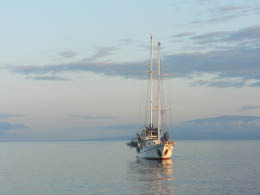
A "classic" tourist boat |
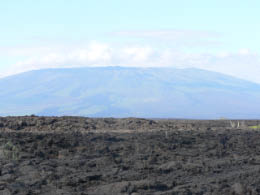
Lava on Isabela Island |
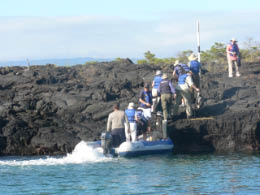
Dry landing |
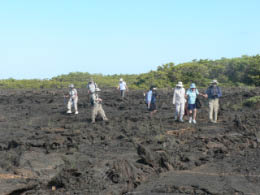
Walking on the lava |
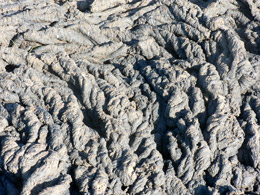
Braid-like lava |
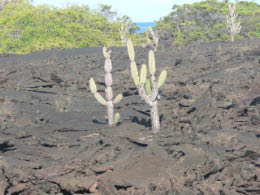
Cactus |
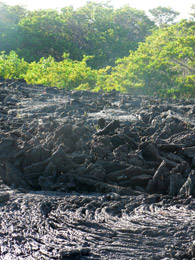
"Fresh" lava (only a million years old) |
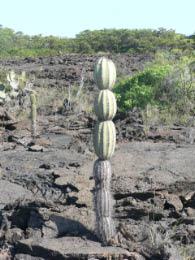
Lone lava cactus |
Scattered about were a few brackish water lagoons surrounded by mangroves. We were jumping with joy when we saw a couple of flamingos fly over looking for a pond to land. Landing can be a trick in a place that’s covered with jagged lava. They circled a few times, put down their landing gear and in no time, were ready to “fish” for shrimp. We hiked to the pond and watched in wonder. Pepe was the most excited. He rarely sees flamingos in these here parts – they’re making a comeback.
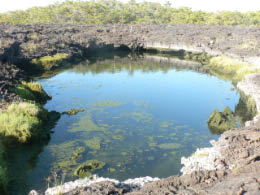
Brackish water lagoon |
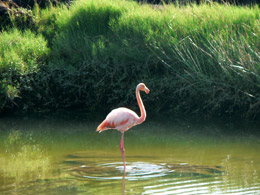
Flamingo |
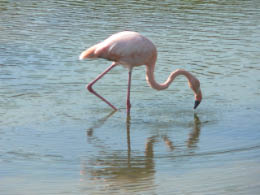
Flamingo |
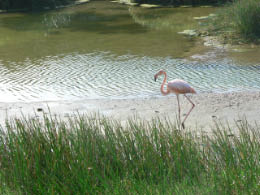
Flamingo |
We saw the occasional iguana and lizard, but not much wildlife. There's simply not much here to sustain life. Maybe in a couple million years the place will be more accommodating. I really enjoyed the hike over the different lava formations. I always love to hike on uneven surfaces that make you focus and pay attention.
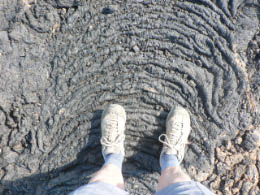
Lava formation |
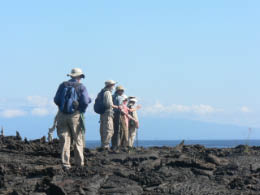
Hiking on lava |
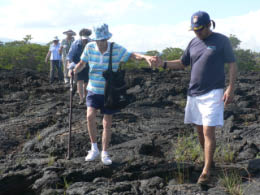
The captain and Frances |
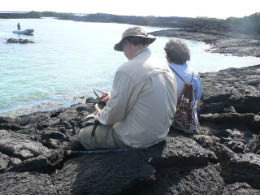
Frank and Susan |
We boarded the panga and did a quick side trip along the rocky shore. We spotted lots of large marine iguanas, a couple of adorable Galapagos penguins and flightless cormorants. It was thrilling to see them so close. We went back to the ship and found William waiting for us with a passion fruit drink and chips. Keeping up with our feeding time must be a chore for the crew.
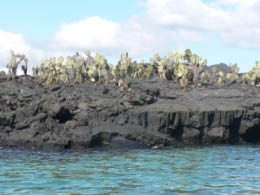
Along the shore |
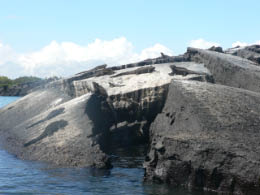
Along the shore |
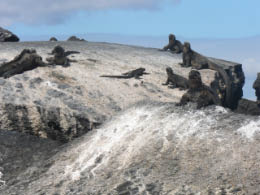
More marine iguanas |
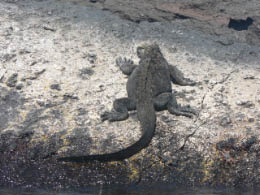
Big guy |
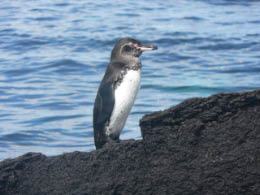
Galapagos penguin |
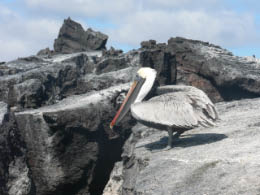
Pelican |
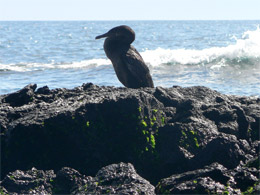
Flightless Cormorant |
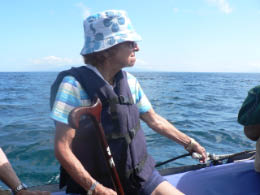
Fran heading back to Archipel II |
We had about 15 minutes to change into our swimsuits for some deep-water snorkeling. Snorkeling was great. We saw sea horses -- actually Pepe had to dive down to point them out to us. He said there was one pregnant male sea horse. We believe whatever he tells us. We watched a giant sea turtle feeding on algae. He was a friendly guy and kept swimming to Lisa and me. We saw all kinds of fish – big, little, colorful, an octopus and some “chocolate chip” star fish. I was mesmerized by the underwater waving seaweed fanning back and forth, swaying with the current. You could get sea sick just watching it. The only time we got rain was when we were in the water – I didn’t even know it was raining. Somebody is watching out for us.
We took the panga back to the ship. We had time to shower and get ready for lunch. Another big lunch – ham, salad, fruit, beans, rice and of course, soup, always fresh, homemade soup.
At 2:00 we boarded the panga to explore Elizabeth Bay. We entered a series of lagoons enclosed by mangroves. The mangrove trees are very thick and tall here. Pepe said, since there are no hurricanes or tornados here in the Galapagos to clear the mangroves out, they continue to grow. Pepe also told us that the mangrove tree doesn’t have a pure filtration system and sends all the salt to some of the leaves. The trees are about 80-90% green, while the scattered yellow leaves are the ones designated to take on the salt. Ain’t nature something?
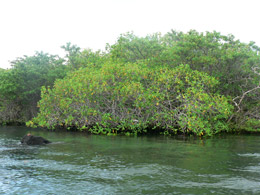
Mangroves |
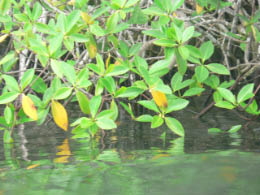
Mangroves with green and yellow leaves |
We cut the engine and paddled into the still waters. The rains came and cooled us off. Pepe said this is a place where the sea turtles come to mate. If they mated in the sea, the females would have a difficult time coming up for air. At first sight, the mangrove swamp seemed void of life. Then a heron greeted us around the corner.
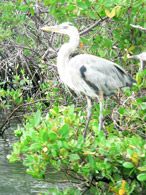
A heron greeted us |
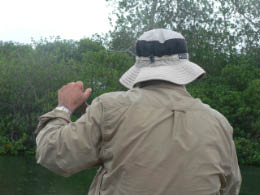
Pepe paddling |
The quietness accented by a bird call here and there was something I won’t forget. That afternoon, we saw it all – penguins, frigates, blue footed boobies, cormorants, marine iguanas, baby sea lions showing off for us, eagle ray, lava herons fishing and beautiful landscape. Just below the surface came the sea turtles, the sea lions and the penguins, full of activity. The birds were up above. We watched one lesser heron on a lower branch of the mangrove tree catching fish after fish. He was very skilled – the others weren’t having as much luck. We left the lagoons in wonder.
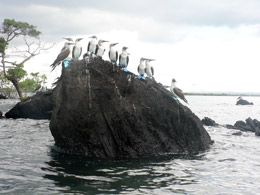
Boobies on the rock |
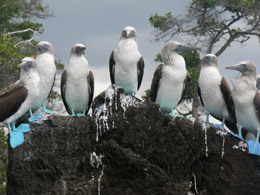
Blue footed boobies |
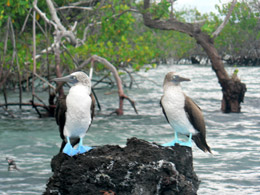
More boobies |
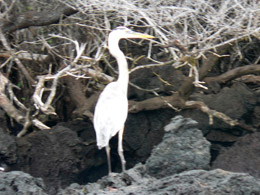
Heron |
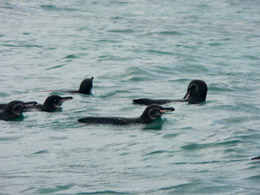
Galapagos penguins |
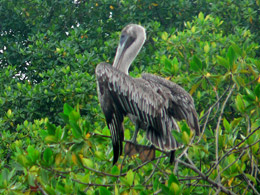
Pelican |
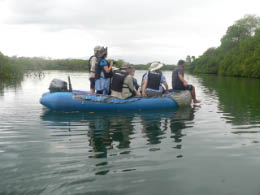
Touring the mangrove lagoon |
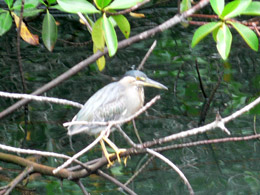
Striated Heron |
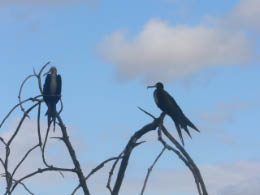
Great Frigatebirds |
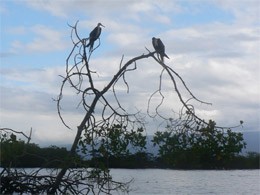
Great Frigatebirds |
We stopped at the ship to get the other panga inflated again. The air leaked out – but hey, no worries here. Then we headed to a series of small islands loaded with life. It was fun just listening to Pepe’s narration. “Dancing Boobies – oh My God – Look, there are two couples. They’ll be copulating soon. Give them their privacy.”
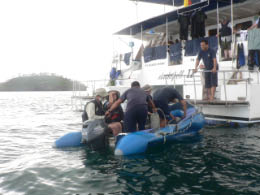
Pit stop to inflate the zodiac |

Happy seafarers |
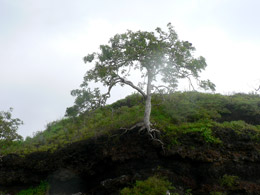
How long will this tree be here? |
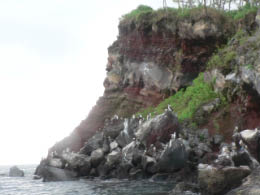
Boobie Bluff |
Next Pepe ordered us to take a picture of the sea lions. “They’ve come to get their pictures taken.” They certainly looked like that’s what they wanted. (Sorry I didn’t get a good shot of them.) They were barking and swimming right along the panga.
We saw penguins, frigates, cormorants and boobies perched on rocks jutting out of the sea. On the way back to the ship, we watched flocks of birds soar overhead, sweeping the waters, looking for dinner. Pepe was happy to show us so many amazing things. It’s something I won’t forget.
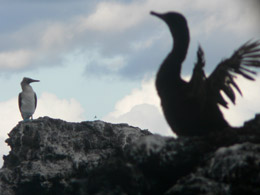
Flightless comorant trying to fly |
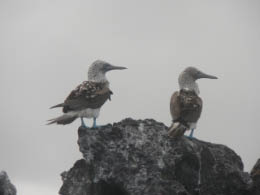
Boobies |
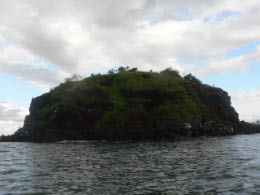
Island |
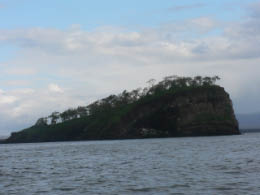
Another island |
We came back on board giddy with excitement. Of course, there was William to greet us with hot hors d'oeuvres – deep fried shrimp. This is the life.
We hung out our things to dry and then hung ourselves out on the sundeck waiting for our next feeding.
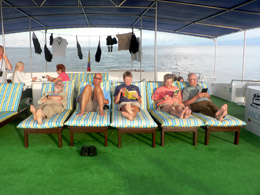
Resting after a tough day |
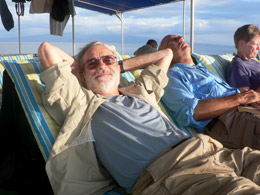
Bill |
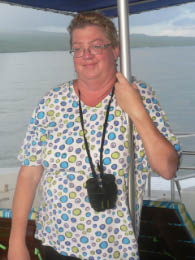
Maureen |
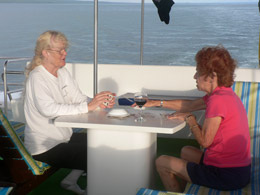
Bonnie and Fran |
After another lovely dinner, we sat and chatted with Steve and Claudia to share our war stories with remodeling and for them, building their own home.
Off to bed to journal and catch up. Another big day ahead tomorrow. |
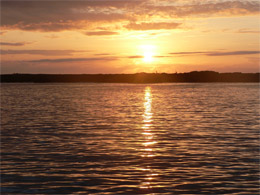
Galapagos sunset |
Sunday, May 1, 2011 – Isabela Island (Tagus Cove) / Fernandina Island
I woke up at 5:00 very cold (the AC was running full blast) so I quietly snuck out of the cabin to make a brew of coffee mixed with cocoa for myself – very good. I saw a couple of crew members sleeping on the deck. It was fun being up before anyone.
The official wake up bell was at 6:00. We boarded the pangas for Tagus Cove and a pre-breakfast hike to Darwin Lake, off Elizabeth Bay. This area is relatively new – about a million and a half years old. Darwin came to check out the finches here in 1835. He was so seasick he had to get off the ship. He set up camp here for 9 days while the ship went for supplies. The iguanas were so thick that he had difficulty setting up his tent. Three years after he left, lava flow from a volcanic eruption wiped out all the trails and finches that he documented. Today we have a crater that’s named, Darwin Lake, after him.
We climbed off the panga on a slippery, algae-covered slope and made our way to the lava trail. There was a lone sea lion with that “take my picture, please” attitude along with a few crabs to greet us.
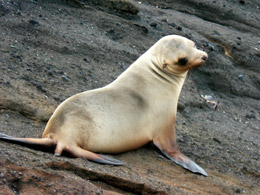
Sea lion at Elizabeth Bay |
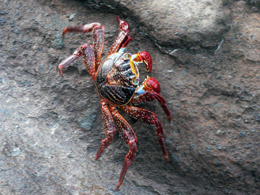
Crab |
Pepe pointed out the graffiti along the coast. The Park decided not to remove this unsightly graffiti. Rather, they left it as an example to show how ugly Galapagos could become. Setting the culture in Galapagos that it’s not OK to express oneself with graffiti is an interesting and wise approach to a universal problem.
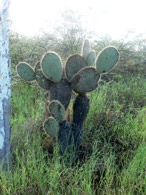
Cactus |
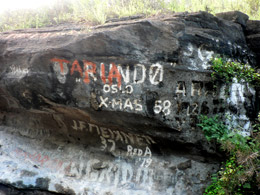
Park decided to leave this Graffiti |
We went straight up 125 steps and then onto the trail. We stopped at several places where Pepe pointed out the Darwin finches and their nests and the various plants.
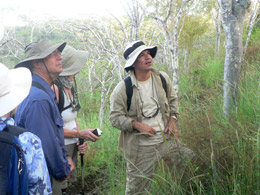
Pepe and his flock . . . |
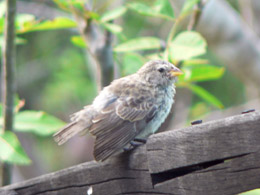
. . . found a Small Ground Finch. . . |
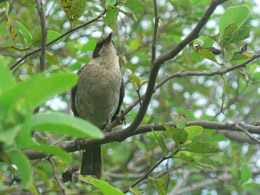
. . . and a Galapagos Flycatcher. . . |
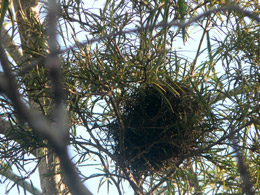
. . . and bird nests |
Our trail was a gorgeous ridge trail with views looking down at Darwin Lake on one side, and a view of our ship anchored in Elizabeth Bay on the other side. Fran made it up the steps and over the trail in her white Keds, with no problem.
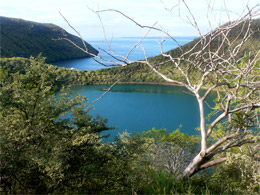
Darwin Lake |
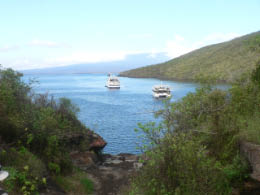
Elizabeth Bay |
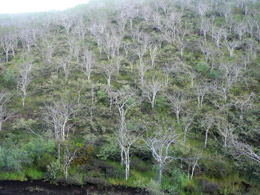
View from Ridge Trail |
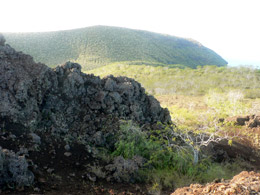
Isabela Island |
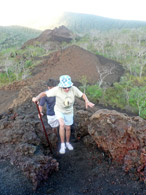
Fran on the trail |
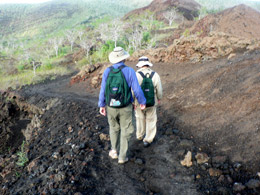
On the trail |
We headed back to the boat for a well-deserved breakfast. After breakfast, we had a few minutes to brush our teeth before it was back to the pangas for a tour around the rocky cliffs and into a few of the caves. The glorious wildlife that fills these little jagged places is something to behold. As we paddled along we saw nazca boobies, blue footed boobies, penguins coming in from their morning swim, flightless cormorants, sea turtles, sea lions, and marine iguanas. As we paddled into the deep dark caves, there was always a bird waiting at the mouth of the cave to greet us. Upon seeing us, the birds on watch never dashed away. They just sat perched above checking out their new visitors.
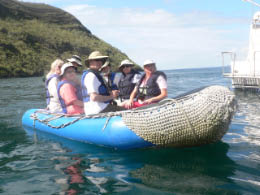
Back to the pangas |
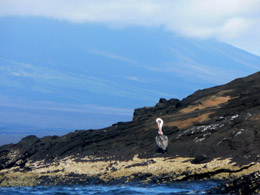
Pelican on Isabela Island |
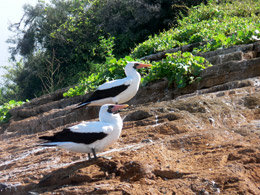
Nazca Boobies |
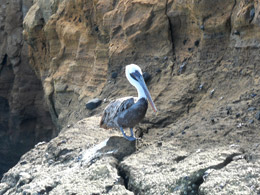
Pelican |
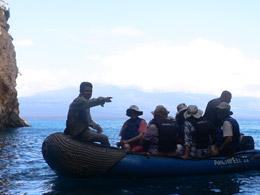
Sea cave |
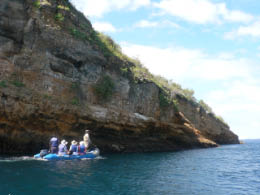
Rocky cliffs |
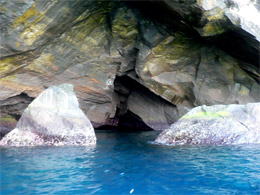
Torquois water |
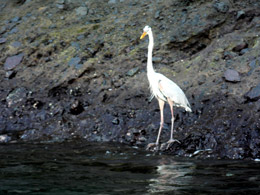
Heron |
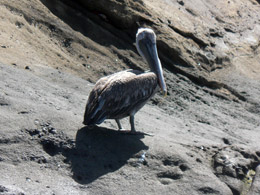
Pelican |
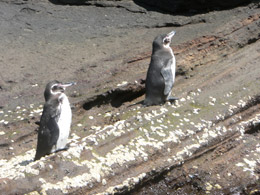
Penguins |
After our exploration, we went back to the boat to change into our swim suits for one last snorkel. It was a deep water snorkel and the grandest snorkel of them all. For an hour, it seemed as if I were in the middle of a delightful, animated Disney movie. Happy penguins darted by. Gentle sea turtles floated upward. A rainbow of fish appeared from time to time along with some sea horses. I could just hear the Calypso music as the soundtrack and I could imagine the crabs coming out playing their bongo drums. (I guess I did let my imagination go a little wild.)
I enjoyed just floating and gazing at the underwater landscape. For miles, dark green algae covered deep canyon walls. A variety of star fish, yellow, green or red, decorated with fascinating geometric designs clung to the wall. I heard Pepe yell, “Golden Rays! Everybody over here to see the Golden Rays.”
| I swam to the deep waters and watched a ghostly sight appear. A large group (or school) of Golden Rays glided upward from the darkness at the bottom of the sea. As they came closer to the surface, I could see the individual rays, with the edges of their lighter undersides folding over, outlining their forms. I could see their long tails gently moving from side to side. After an hour of this amazing, unreal world, each of us came up out of the water and flung ourselves into the waiting dingy in awe. I will never have another experience like that -- and to think I dreaded the snorkeling part of the trip. |
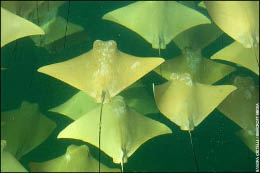
Golden Rays (photo from the Internet, but they looked just like this) |
We got back to the ship, rinsed out our swim suits and had lunch. We were delighted to have a tender filet mignon. Chef Wellington can really cook. BRAVO!
We got to tour the crew s’ quarters and the galley down below. We were amazed that all that marvelous food was prepared in a tiny kitchen that probably rocks and rolls! We also couldn’t believe the bunk beds and a dining table for the crew crammed in one tiny little room next to the kitchen.
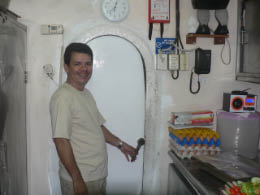
Pepe in the Galley |
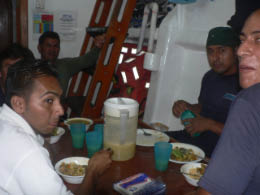
Archipel II crew |
We went back to our big, luxurious cabins to get ready for another adventure. Oops, we’re almost out of sunscreen. That means it’s time to go home.
At 2:00 we boarded the panga for Espinoza Point on Fernandina Island, the western most island in the Galapagos. We had a dry landing, but because it was high tide, the first part of the trail was underwater. We grabbed onto the branches of the mangrove trees and made our way through the swamp to the dry trail. It was like being a kid again and hanging out with your friends, down at the creek.

Heading to Fernandina Island |
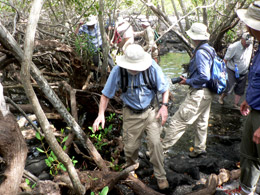
Making our way at high tide |
Fernandina is the youngest of the islands – only 300,000 years old. It’s only a baby, geologically speaking, and the most pristine island in the Galapagos. The lava landscape was beautifully sculptured by Mother Nature – twisted mounds molded into rounded domes. There were not many plants or mangroves. Pepe called one area “lava cactus forest” because here, the cactus plants were just starting to take over. We saw scattered plants and scrubs getting a foothold in this no man’s land. (And no man has ever lived here – dropped in for a stroll, maybe, but never lived here!)
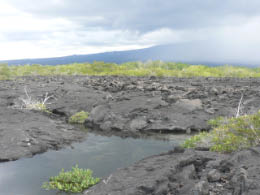
Fernandina |
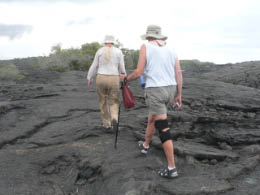
Fernandina |
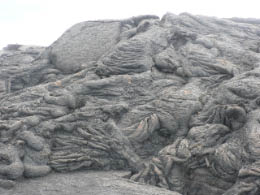
Twisted mounds of lava |
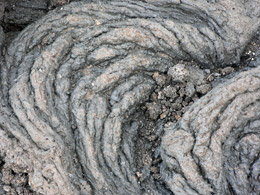
Lava landscape |
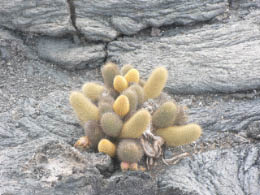
Cactus on Fernandina |
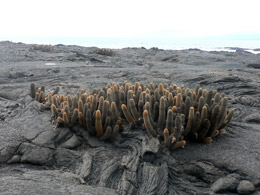
Lava cactus forest |
The large marine iguanas covered the place – hundreds and hundreds of them covered the lava shoreline. We were all nervous about stepping on one because they blended so well with the landscape and there were so many of them. The trail was mostly over lava, sectioned off by wooden stakes in the ground. The rules to stay only on the trail are important to keep from disturbing the iguanas’ nesting areas.
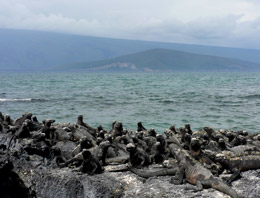
Marine iguanas |
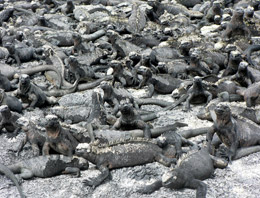
More marine iguanas |
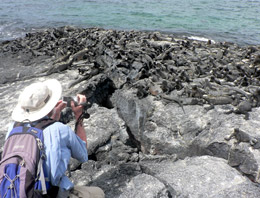
Bill with his video camera |
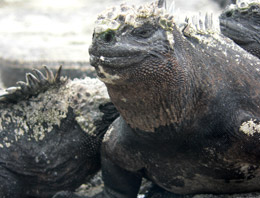
Isn't he cute? |
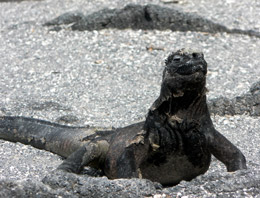
Marine iguana |
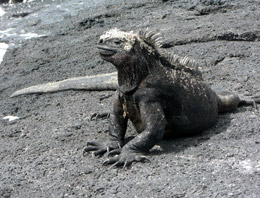
Marine iguana |
We saw a skeleton of a whale that was beached back in 1982. We watched a few sea lions come in from fishing. When they saw us, they began posing for pictures – those little rascals. We saw a Galapagos Hawk high in one of the few trees on the islands and spotted a couple of cormorants hanging out with the iguanas. I took a picture of a lava lizard – the only one I documented on the whole trip.
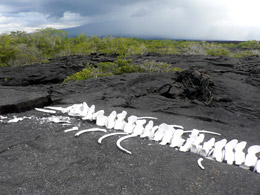
Whale bones |
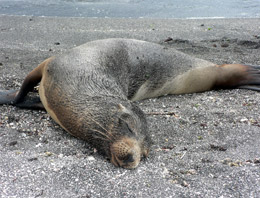
Sleeping sea lion |
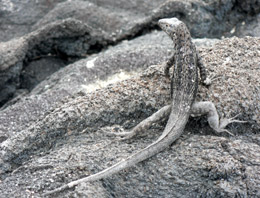
Lava lizard |
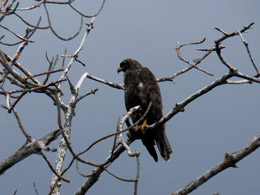
Galapagos Hawk |
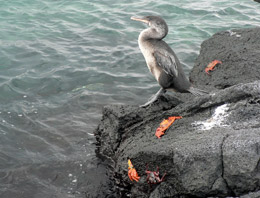
Flightless cormornat |
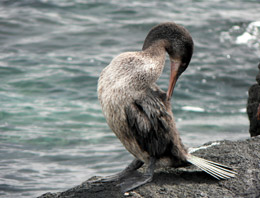
Flightless cormornat |
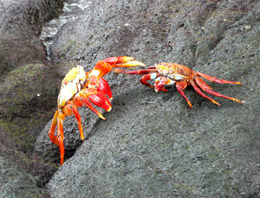
Colorful crab |
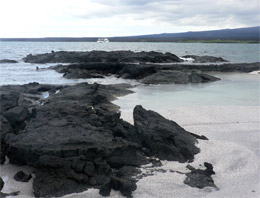
Lava shoreline |
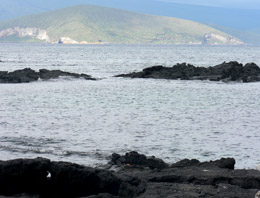
Island |
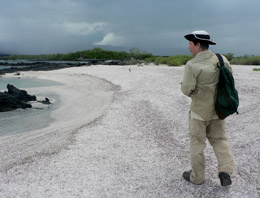
Pepe on the beach |
Pepe said the Park Officials may close the island because they found some rats by chance and eradicated them. They think the rats were brought in by the fisherman. They take conservation very seriously here and what a treasure they have!
Back at the boat, we did the usual – got a beer from William at the bar and hung out on the sundeck. At 4:30, Chef Wellington (25 years old with 8 years of experience) showed us how to make ceviche. It was the best we’ve ever had.
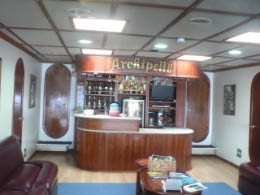
Archipel II Bar |
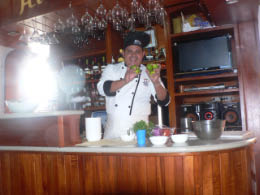
Wellington, our chef |
At 5:30, William (the all-around-do-anything-for you kind of crew guy) did a show for us. With the assistance of the captain and the chef (acting as pretend musicians), William performed a couple of dances from his region in the Ecuadorian Highlands. The first was very emotional showing the grief and pain associated with burying ancestors and their possessions in a jar. (For the ancestor jar, William substituted a stock pot from the kitchen – but the feeling and drama were real.) The second dance was festive and lighthearted. William asked me to join him – big mistake. I’m so uncoordinated and dancing on a boat out at sea is next to impossible for me. I pranced around a little and then fell into Sharon’s lap. The audience gasped, but I jumped up quickly saying, “I’m OK … I’m OK.”
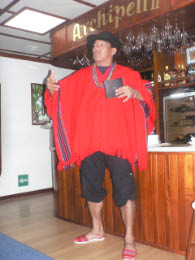
William |

Nancy, traditional dance |

I'm OK |
Next we crossed the equator. Our group huddled behind our captain and Pepe in the wheelroom and watched the boat’s GPS countdown to 00:00:00. Of course, William was there serving drinks to toast “the northern hemisphere.” Then we saw a beautiful sunset and had to toast that.

Archipel II's GPS at the Equator |
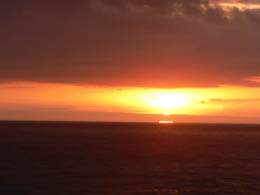
Beautiful sunset |
The drinking was not over. William made a farewell drink that he called “Hasta La Vista.” Following our toasting, came an “over the top” farewell fresh fish dinner, with another complimentary glass of wine.
The celebration and camaraderie didn’t end after dinner. William brought out a lovely “leche” cake for Steve’s birthday. Steve’s not a big party animal and was very low-keyed about his impromptu party. However, the rest of us were happy to have a piece of special cake. The group indeed has bonded. The once-quiet group was now chatting all at once and didn’t want to leave the table and go off to our individual cabins to pack. So many wonderful people and wonderful memories.

Cheers! |
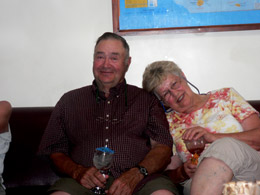
Gene and Sharon |
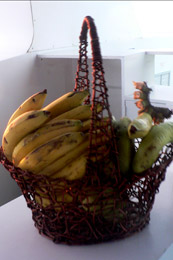
Bananas, Nancy's favorite |

Bill and Nancy at Susnet |
Monday, May 2, 2011 – Santa Cruz Island /Flight to Quito
I missed the 5:30 wake up bell and also missed the big waves last night – maybe a little too much celebration. Bill woke me up about 5:40 and said we’d be leaving at 6. I stumbled out of bed, threw on some clothes and dashed out of the cabin to make my chocolate coffee concoction to get me going.
In no time we were loaded on the pangas and motoring to Bachas beach on Santa Cruz Island. We had a wet landing on a very beautiful sandy shore line. We roamed over the lava trails on this lovely island. The early morning sunlight was heavenly. We watched a single flamingo in a brackish pond. There’s always a marine iguana to greet you. Pepe pointed out a lobster on the sand and said, “Look, he’s evolving into a land lobster right now.” (And that’s just about how fast evolution happens in the Galapagos!) We saw some sea turtle nesting areas. One nest contained a cracked and empty turtle egg shell. The evidence was clear – leading to the edge of the crime scene (the nest), telltale (tail) frigate’s foot prints were left in the sand. (Breakfast for one / Future generations for another.)
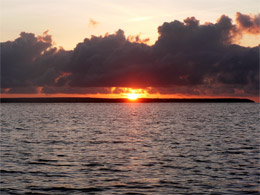
Sunrise on Santa Cruz |
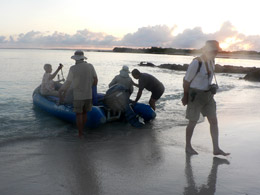
Wet landing on Bachas Beach |
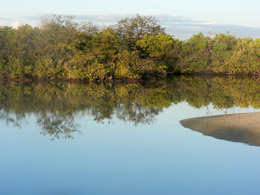
Pond with flamingo |
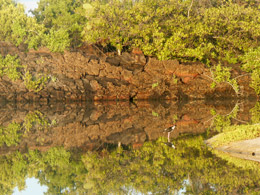
Reflections |
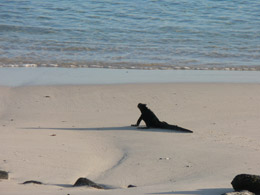
Marine iguana to greet us |
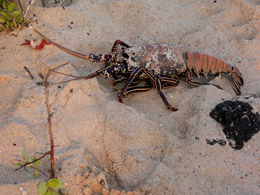
Evolving to a land lobster |
The last trek on the Galapagos in the early morning took on a different aura. It wasn’t about absorbing facts or checking things off a list. It was about reflecting and summing up one amazing week. I felt so thankful for having seen such a place with such a good group of people. We walked quietly knowing this grand adventure would be over and we’d be returning home to our everyday lives. I filled my heart with the beauty around me and said a little “good-bye” – Good-bye sea lions, good-bye marine iguanas, good-bye finches, good-bye friends, good-bye beaches . . . You get the picture. I’ll stop now.
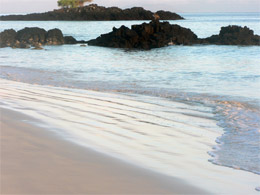
Last look at the beach |
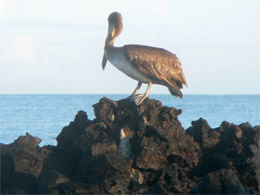
Pelican |
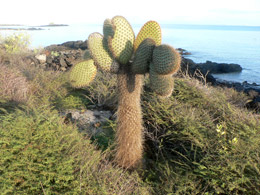
Cactus |
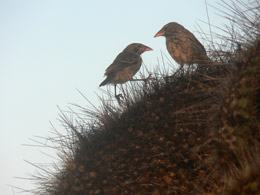
Cactus finches |
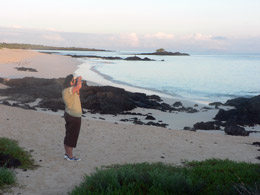
Susan taking final photos |
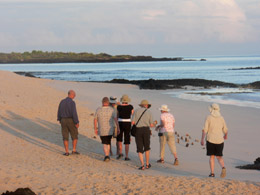
Our last stroll on the beach |
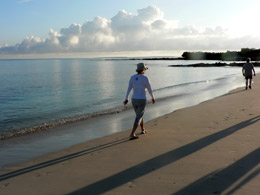
Morning shadows |
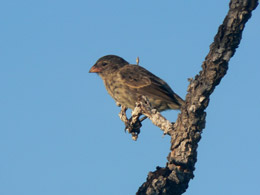
Small Ground Finch |
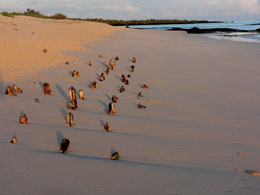
Remnants for an old pier |
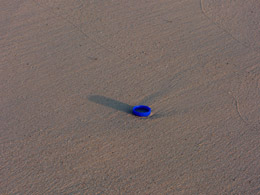
The only litter we saw |
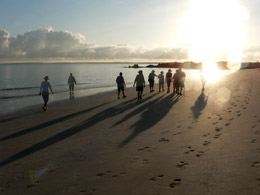
Heading back to the panga one last time |
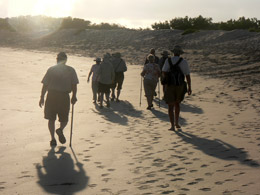
Goodbye Galapagos |
We watched 4 panga loads of “invaders” as Pepe calls them, come ashore. Humans are the biggest predator of all. We walked quietly to board the panga, knowing this was our last adventure in the Galapagos.
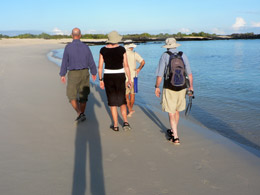
Last look at the beach |
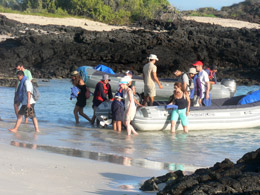
“Invaders” |
We came back on board for our last breakfast – this morning it was cereal with yogurt, scrambled eggs, toast, fruit and banana pancakes (enough with the bananas!).
We went back to our cabins to pack up. Then we loaded on the panga and headed for Baltra Island (and the airport). You could see Galapagos sharks swimming in the water. (I need a little theme music from Jaws, please.) The welcoming committee of sea lions was waiting at the dock. We waited for the bus and watched brown pelicans and frigates with red bags hanging as they soared overhead.
The bus took us to the airport – only about 3 minutes away. (The U.S. had a military base on Balta so I assume that’s why the airport is here.) It was hot and humid and the crowds are restless – but Pepe and I found a place under the whirling fans in the boarding area. He was on his blackberry entering notes from our trip; I was on my netbook, journaling about our trip.
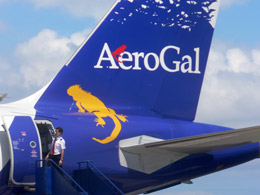
Our plane back to Quito |
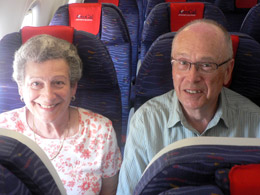
Lisa and David |
I took a few pictures from the plane and remembered Quito and the volcanoes around it. It seemed months ago when we last saw Quito, not just a week. (Life is certainly packed.)
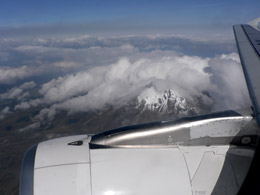
Snow capped peaks |
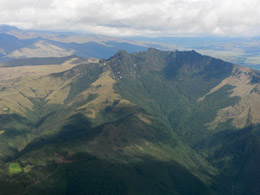
View from the plane |
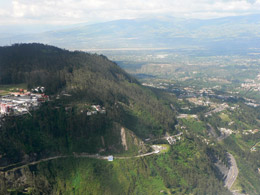
Arriving at Quito |
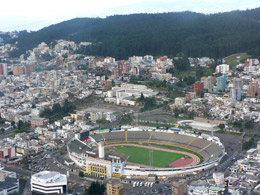
Quito fútbol (soccer) stadium |
We landed in Quito about 4:30. Sofy was there to meet us. It was good to see her smiling face again. We boarded the bus and went to our hotel. We showered and re-organized all our stuff yet again.
We tuned on the TV news (Aljazeera, the only English language news station) to find out what has been happening in the outside world. We learned that the US finally got Osama Bin Ladin. He was assassinated by Navy Seals in Pakistan. Looks like we got the bad guy, but we’re uneasy about where all this is going to lead.
We met Sofy at 6:30 for a de-briefing meeting and talked about all the things we saw and learned. I loved the trip.
We boarded the bus and went to our farewell dinner hosted in a private museum – Museo Mindalae. We visited 4 floors and learned about shaman ceremonies, crafts, basket weaving, textiles, pots and other handicrafts. It was a nicely done museum and the coolest bathroom design ever.
The fish dinner was good. It’s a nice environment for dining. We sat across from Sharon and Eugene and got to chat with them. There was another birthday cake and celebration for Steve. He really doesn’t like the attention. After dinner, we looked in the gift shop, boarded the bus and were back at the hotel by 10:00. We have a wakeup call at 3:45 (Say it isn’t so). The plane leaves at 6:40 – Lord, have mercy on us!
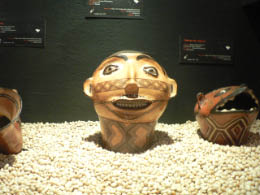
Museo Mindalae |
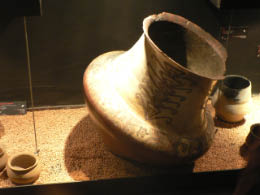
Museo Mindalae |
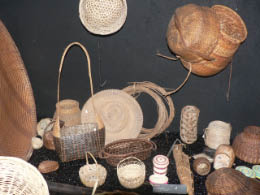
Museo Mindalae |
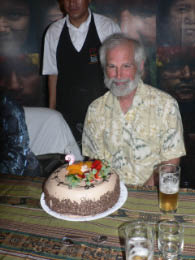
Steve with his cake |
Tuesday, May 3, 2011 – Flight day home
David and Lisa were the other unlucky ones to have such an insanely early flight out of Quito. We commiserated in the lobby, on the bus and in the endless lines for check in, passport control, etc. I’m glad we have a support group around – they’re adorable.
I put myself on auto-pilot for the three flights we were facing today – Quito to Miami, Miami to Dallas and Dallas to San Diego. I spent most of the time journaling on the netbook – until the battery ran out after 6 hours. Then I thought about the grand trip and the beautiful memories Bill and I now have. My thoughts turned to home the closer I got to San Diego. Yes, it will be nice to be home.
Our very good neighbors, Everett and Oksana, picked us up at the airport and had us home by 8:30. We left our bags by the door and dashed over to see our family – before Zion’s bedtime. Zi was excited about her trip to Sacramento and I was excited to be home.
|











